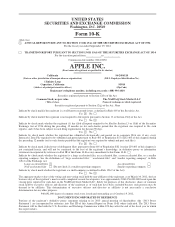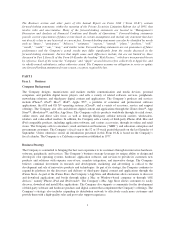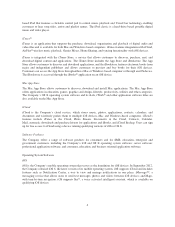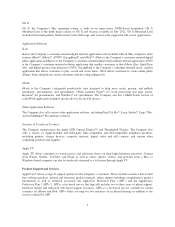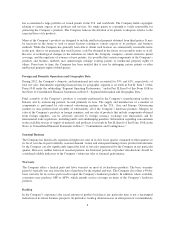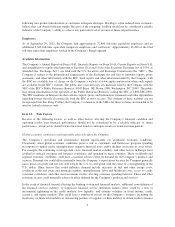Apple 2012 Annual Report Download - page 2
Download and view the complete annual report
Please find page 2 of the 2012 Apple annual report below. You can navigate through the pages in the report by either clicking on the pages listed below, or by using the keyword search tool below to find specific information within the annual report.The Business section and other parts of this Annual Report on Form 10-K (“Form 10-K”) contain
forward-looking statements, within the meaning of the Private Securities Litigation Reform Act of 1995, that
involve risks and uncertainties. Many of the forward-looking statements are located in “Management’s
Discussion and Analysis of Financial Condition and Results of Operations.” Forward-looking statements
provide current expectations of future events based on certain assumptions and include any statement that does
not directly relate to any historical or current fact. Forward-looking statements can also be identified by words
such as “future,” “anticipates,” “believes,” “estimates,” “expects,” “intends,” “plans,” “predicts,” “will,”
“would,” “could,” “can,” “may,” and similar terms. Forward-looking statements are not guarantees of future
performance and the Company’s actual results may differ significantly from the results discussed in the
forward-looking statements. Factors that might cause such differences include, but are not limited to, those
discussed in Part I, Item 1A of this Form 10-K under the heading “Risk Factors,” which are incorporated herein
by reference. Each of the terms the “Company” and “Apple” as used herein refers collectively to Apple Inc. and
its wholly-owned subsidiaries, unless otherwise stated. The Company assumes no obligation to revise or update
any forward-looking statements for any reason, except as required by law.
PART I
Item 1. Business
Company Background
The Company designs, manufactures and markets mobile communication and media devices, personal
computers, and portable digital music players, and sells a variety of related software, services, peripherals,
networking solutions, and third-party digital content and applications. The Company’s products and services
include iPhone®, iPad®, Mac®, iPod®, Apple TV®, a portfolio of consumer and professional software
applications, the iOS and OS X®operating systems, iCloud®, and a variety of accessory, service and support
offerings. The Company also sells and delivers digital content and applications through the iTunes Store®, App
StoreSM, iBookstoreSM, and Mac App Store. The Company sells its products worldwide through its retail stores,
online stores, and direct sales force, as well as through third-party cellular network carriers, wholesalers,
retailers, and value-added resellers. In addition, the Company sells a variety of third-party iPhone, iPad, Mac and
iPod compatible products, including application software, and various accessories, through its online and retail
stores. The Company sells to consumers; small and mid-sized businesses (“SMB”); and education, enterprise and
government customers. The Company’s fiscal year is the 52 or 53-week period that ends on the last Saturday of
September. Unless otherwise stated, all information presented in this Form 10-K is based on the Company’s
fiscal calendar. The Company is a California corporation established in 1977.
Business Strategy
The Company is committed to bringing the best user experience to its customers through its innovative hardware,
software, peripherals, and services. The Company’s business strategy leverages its unique ability to design and
develop its own operating systems, hardware, application software, and services to provide its customers new
products and solutions with superior ease-of-use, seamless integration, and innovative design. The Company
believes continual investment in research and development, marketing and advertising is critical to the
development and sale of innovative products and technologies. As part of its strategy, the Company continues to
expand its platform for the discovery and delivery of third-party digital content and applications through the
iTunes Store. As part of the iTunes Store, the Company’s App Store and iBookstore allow customers to discover
and download applications and books through either a Mac or Windows-based computer or through “iOS
devices,” namely iPhone, iPad and iPod touch®. The Company’s Mac App Store allows customers to easily
discover, download and install Mac applications. The Company also supports a community for the development
of third-party software and hardware products and digital content that complement the Company’s offerings. The
Company’s strategy also includes expanding its distribution network to effectively reach more customers and
provide them with a high-quality sales and post-sales support experience.
1

